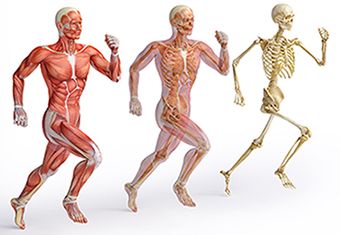The musculoskeletal system consists of the bones, muscles, tendons, ligaments, and joints in our body. It provides the framework and support necessary for movement and stability. Maintaining a healthy musculoskeletal system is crucial for overall well-being and quality of life. Regular exercise plays a significant role in promoting and preserving musculoskeletal health.
Importance of Musculoskeletal Health
A strong and healthy musculoskeletal system is essential for performing daily activities and maintaining independence. It enables efficient and pain-free movement, allowing us to walk, run, lift, and carry objects without limitations. Good musculoskeletal health is also crucial for proper posture and balance, reducing the risk of falls and injuries. Furthermore, the musculoskeletal system protects vital organs and supports their functions. For example, the rib cage protects our heart and lungs, while the spine provides stability and protection for the spinal cord.
Benefits of Exercise on Musculoskeletal Health
Engaging in regular exercise offers a wide range of benefits for the musculoskeletal system. Here are some key advantages:
1. Strengthening of Bones
Weight-bearing exercises, such as walking, jogging, and weightlifting, encourage bone formation and increase bone density. This helps prevent conditions like osteoporosis and osteopenia, which are characterized by weak and brittle bones.
2. Muscle Development
Exercise promotes muscle growth and strength. Resistance training, in particular, helps build lean muscle mass and improves muscle tone. Having strong muscles supports joint stability, making movements more efficient and reducing the risk of injuries.
3. Joint Health
Regular exercise helps improve the flexibility and stability of joints. It stimulates the production of synovial fluid, which lubricates the joints and reduces friction. This is beneficial for individuals with conditions like arthritis, as it can alleviate pain and improve their range of motion.
4. Posture and Balance
Exercises that target core muscles, such as Pilates and yoga, improve posture and balance. They strengthen the muscles surrounding the spine and pelvis, promoting proper alignment and reducing the risk of back pain.
5. Enhanced Coordination and Agility
Engaging in activities that require balance and coordination, such as dancing or martial arts, improves motor skills and agility. These exercises challenge the musculoskeletal system, enhancing its functionality and overall performance.
6. Pain Management
Exercise has been shown to reduce musculoskeletal pain, including chronic conditions like fibromyalgia. Regular physical activity increases the production of endorphins, which are natural pain-relieving substances. It also helps strengthen the muscles around the affected areas, providing additional support and reducing discomfort.
Types of Exercises for Musculoskeletal Health
When it comes to improving musculoskeletal health, it is important to engage in a variety of exercises that target different aspects of the system. Here are some examples:
1. Weight-Bearing Exercises
Activities that involve bearing your own body weight, such as walking, dancing, and stair climbing, promote bone health and increase bone density.
2. Resistance Training
Lifting weights or using resistance bands helps build and strengthen muscles. It is important to focus on all major muscle groups, including the arms, legs, back, and core.
3. Flexibility and Stretching
Stretching exercises, like yoga and Pilates, improve flexibility and joint range of motion. They also help relieve muscle tension and improve posture.
4. Cardiovascular Exercise
Aerobic exercises, such as swimming, cycling, and running, promote overall cardiovascular health. They increase blood circulation, which nourishes the muscles and joints.
5. Balance and Stability Training
Exercises that challenge balance, such as tai chi or balance boards, improve stability and reduce the risk of falls. These activities also promote better posture and coordination.
Tips for Maintaining Musculoskeletal Health
In addition to regular exercise, there are other important factors to consider for maintaining optimal musculoskeletal health. Here are some tips:
1. Adequate Nutrition
A balanced diet rich in calcium, vitamin D, and other essential nutrients supports bone health and muscle function. Incorporate foods like dairy products, green leafy vegetables, and lean proteins into your meals.
2. Proper Posture
Maintaining good posture is essential for reducing strain on muscles and joints. Practice proper ergonomics at work, use supportive pillows for sleep, and be mindful of your posture throughout the day.
3. Avoid Prolonged Inactivity
Avoid sitting or standing in the same position for prolonged periods as it can lead to muscle stiffness and poor circulation. Take breaks and engage in light stretches or movements every hour.
4. Listen to Your Body
Pay attention to any pain or discomfort during exercise. If something doesn't feel right, modify the activity or consult a healthcare professional for guidance.
5. Stay Hydrated
Proper hydration is essential for maintaining healthy joints and muscles. Drink an adequate amount of water throughout the day, especially during exercise.
Incorporating Exercise into Your Routine
To make exercise a habit, start small and gradually increase your activity levels. Find activities you enjoy and mix them up to keep things interesting. Set realistic goals and stay consistent. Remember to warm up before exercising and cool down afterwards to prevent injuries. It is always advisable to consult with a healthcare professional or a qualified fitness instructor before starting any new exercise program, especially if you have existing musculoskeletal conditions or injuries.
Conclusion
Maintaining good musculoskeletal health is essential for overall well-being and an active lifestyle. Regular exercise, along with proper nutrition and lifestyle habits, plays a crucial role in promoting and preserving the health of our bones, muscles, tendons, ligaments, and joints. By incorporating a variety of exercises into our routine and adopting healthy habits, we can support our musculoskeletal system and improve our quality of life.
